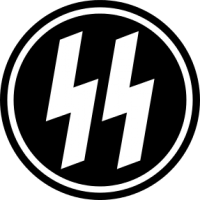Gestapo: Difference between revisions
| Line 136: | Line 136: | ||
== Identification: Criminal Local Police ID Tag - Oval - Nickel or Brass == | == Identification: Criminal Local Police ID Tag - Oval - Nickel or Brass == | ||
[[]] | [[File:Gestapo ID Tags.jpg]] | ||
<br> | <br> | ||
<br> | <br> | ||
Worn by the plain clothes Police and Security services and the Army Secret Field Police, they were presented as proof of identity when on duty. These units were small in comparison to military units and many discs were destroyed at war’s end in order to hide identities and thus avoid prosecution. | Worn by the plain clothes Police and Security services and the Army Secret Field Police, they were presented as proof of identity when on duty. These units were small in comparison to military units and many discs were destroyed at war’s end in order to hide identities and thus avoid prosecution. | ||
Revision as of 13:07, 17 March 2017
Introduction
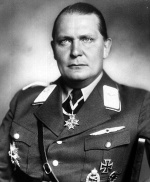
The Gestapo, abbreviation of Geheime Staatspolizei, or the Secret State Police, was the official secret police of Nazi Germany and German-occupied Europe.
The force was created by Hermann Göring in 1933 by combining the executive and the judicial branches into one power. Beginning on 20 April 1934, it was under the administration of Schutzstaffel (SS) national leader Heinrich Himmler, who in 1936 was appointed Chief of German Police (Chef der Deutschen Polizei) by Hitler. In 1936, Himmler made it a suboffice of the Sicherheitspolizei (SiPo) ("Security Police"). Then from 27 September 1939 forward, it was administered by the Reichssicherheitshauptamt (RSHA) ("Reich Main Security Office") and was considered a sister organization of the Sicherheitsdienst (SD) ("Security Service").
Predecessor Organization
The Prussian Secret Police (German: Preußische Geheimpolizei) was the political police agency of the German state of Prussia in the 19th and early 20th centuries.
In 1851 Police Union of German States was set up by the police forces of Austria, Prussia, Bavaria, Saxony, Hanover, Baden, and Württemberg. It was specifically organised to suppress political dissent in the wake of the 1848 revolutions which spread across Germany. For the next fifteen years the Union held annual meetings to exchange information. Karl Ludwig Friedrich von Hinckeldey, the Police Commissioner of Berlin was appointed by King Friedrich Wilhelm IV on November 16, 1848. He was to prove to be a key figure in the development of the secret police in Prussia as well as the whole union. By 1854, thanks to his close relationship with the King he was appointed Generalpolizeidirektor (General Director of Police). Effectively he was a minister of police independent from the minister of the interior. Von Hinckeldey founded the Berlin political police in Berlin and developed a Prussian information catalogue on political opponents, focusing on revolutionaries involved in the 1848 uprisings. But as he saw Paris and London as the centers of political intrigue he was keen to organize the policing of political opponents outside borders of national jurisdictions.
The Prussian Secret Police has historically held a bad reputation, as it was the model upon which the Gestapo was later founded. The Prussian Secret Police, however, did not routinely engage in persecution or the abuse of police powers, and did not behave in the way that other secret police forces might.
The Prussian Secret Police ceased to exist in 1933 with the founding of the Gestapo. Prussia itself was dissolved as an administrative entity following World War II.
History
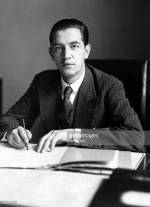
As part of the agreement in which Adolf Hitler became Chancellor of Germany, Hermann Göring—future commander of the Luftwaffe and the number two man in the Nazi Party—was named Interior Minister of Prussia. This gave Göring command of the largest police force in Germany. Soon afterward, Göring detached the political and intelligence sections from the police and filled their ranks with Nazis. On 26 April 1933, Göring merged the two units as the Geheime Staatspolizei, which was abbreviated for a franking stamp and became known as the Gestapo. He originally wanted to name it the Secret Police Office (German: Geheimes Polizeiamt), but discovered the German initials "GPA" looked and sounded too much like those of the Russian GPU.
Its first commander was Rudolf Diels, a protégé of Göring. Diels was appointed with the title of chief of Abteilung Ia (Department 1a) of the Political Police of the Prussian Interior Ministry. Diels was best known as the primary interrogator of Marinus van der Lubbe after the Reichstag fire. In late 1933, the Reich Interior Minister Wilhelm Frick wanted to integrate all the police forces of the German states under his control. Göring outflanked him by removing the Prussian political and intelligence departments from the state interior ministry. Göring himself took over the Gestapo in 1934 and urged Hitler to extend the agency's authority throughout Germany. This represented a radical departure from German tradition, which held that law enforcement was (mostly) a Land (state) and local matter. In this, he ran into conflict with Heinrich Himmler, who was police chief of the second most powerful German state, Bavaria. Frick did not have the muscle to take on Göring by himself so he allied with Himmler. With Frick's support, Himmler (pushed on by his right-hand man, Reinhard Heydrich) took over the political police of state after state. Soon only Prussia was left.
Concerned that Diels was not ruthless enough to effectively counteract the power of the Sturmabteilung (SA), Göring handed over control of the Gestapo to Himmler on 20 April 1934. Also on that date, Hitler appointed Himmler chief of all German police outside Prussia. Heydrich, named chief of the Gestapo by Himmler on 22 April 1934, also continued as head of the SS Security Service (Sicherheitsdienst, SD). Himmler and Heydrich both immediately began installing their own personnel in select positions, several of whom were directly from the Bavarian Political Police like Heinrich Müller, Franz Josef Huber, and Josef Meisinger. Many of the Gestapo employees in the newly established offices were young and highly educated in a wide-variety of academic fields and moreover, represented a new generation of National Socialist adherents, who were hard-working, efficient, and prepared to carry the Nazi state forward through the persecution of their political opponents.
By the spring of 1934 Himmler's SS controlled the SD and the Gestapo, but for him, there was still a problem, as technically the SS (and the Gestapo by proxy) was subordinated to the SA which was under the command of Ernst Roehm. Himmler wanted to free himself entirely from Roehm, who he viewed as an obstacle. Roehm's position was menacing as upwards of over 4.5 million men fell under his command once the militias and veterans organizations were absorbed by the SA, a fact which fueled Roehm's aspirations; his dream of fusing the SA and Reichswehr together was undermining Hitler's relationships with the leadership of Germany's armed forces. Several Nazi chieftains, among them Goering, Joseph Goebbels, Rudolf Hess, and Himmler, began a concerted campaign to convince Hitler to take action against Roehm. Both the SD and Gestapo released information concerning an imminent putsch by the SA. Once persuaded, Hitler acted by setting Himmler's SS into action, who then proceeded to murder over 100 of Hitler's identified antagonists. While members of the Gestapo did not participate in the killing, they supplied the information which implicated the SA and ultimately enabled Himmler and Heydrich to emancipate themselves entirely from the organization. For the Gestapo, the next two years following the Night of the Long Knives, a term describing the putsch against Roehm and the SA, were characterized by "behind-the-scenes political wrangling over policing."
On 17 June 1936, Hitler decreed the unification of all police forces in the Reich and named Himmler as Chief of German Police. This action effectively merged the police into the SS and removed it from Frick's control. Himmler was nominally subordinate to Frick as police chief, but as Reichsführer-SS, he answered only to Hitler. This move also gave Himmler operational control over Germany's entire detective force. The Gestapo became a national state agency. Himmler also gained authority over all of Germany's uniformed law enforcement agencies, which were amalgamated into the new Ordnungspolizei (Orpo: Order Police), which became a national agency under SS general Kurt Daluege. Shortly thereafter, Himmler created the Kriminalpolizei (Kripo: Criminal Police), merging it with the Gestapo into the Sicherheitspolizei (SiPo: Security Police), under Heydrich's command. Heinrich Müller was at that time the Gestapo operations chief. He answered to Heydrich; Heydrich answered only to Himmler and Himmler answered only to Hitler.
The Gestapo had the authority to investigate cases of treason, espionage, sabotage and criminal attacks on the Nazi Party and Germany. The basic Gestapo law passed by the government in 1936 gave the Gestapo carte blanche to operate without judicial review—in effect, putting it above the law. The Gestapo was specifically exempted from responsibility to administrative courts, where citizens normally could sue the state to conform to laws. As early as 1935, a Prussian administrative court had ruled that the Gestapo's actions were not subject to judicial review. The SS officer Werner Best, onetime head of legal affairs in the Gestapo, summed up this policy by saying, "As long as the police carries out the will of the leadership, it is acting legally."
On 27 September 1939, the security and police agencies of Nazi Germany—with the exception of the Orpo—were consolidated into the Reich Main Security Office (RSHA), headed by Heydrich. The Gestapo became Amt IV (Department IV) of RSHA and Müller became the Gestapo Chief, with Heydrich as his immediate superior. After Heydrich's 1942 assassination, Himmler assumed the leadership of the RSHA until January 1943, when Ernst Kaltenbrunner was appointed chief. Müller remained the Gestapo Chief. Adolf Eichmann headed the Gestapo's Office of Resettlement and then its Office of Jewish Affairs (Referat IV B4 or Sub-Department IV, Section B4). He was Müller's direct subordinate.
The power of the Gestapo included the use of what was called, Schutzhaft—"protective custody", a euphemism for the power to imprison people without judicial proceedings. An oddity of the system was that the prisoner had to sign his own Schutzhaftbefehl, an order declaring that the person had requested imprisonment—presumably out of fear of personal harm. In addition, thousands of political prisoners throughout Germany—and from 1941, throughout the occupied territories under the Night and Fog Decree—simply disappeared while in Gestapo custody. During World War II, the Gestapo was expanded to around 46,000 members. After Heydrich's death in June 1942, and as the war progressed, Müller's power and the independence grew substantially. This trickled down the chain of his subordinates. It led to much more independence of action.
Counterintelligence
The Polish government in exile in London during World War II received sensitive military information about Nazi Germany from agents and informants throughout Europe. After Germany conquered Poland in the autumn of 1939, Gestapo officials believed that they had neutralized Polish intelligence activities. However, certain Polish information about the movement of German police and SS units to the East during the German invasion of the Soviet Union in the autumn of 1941 was similar to information British intelligence secretly got through intercepting and decoding German police and SS messages sent by radio telegraphy.
In 1942, the Gestapo discovered a cache of Polish intelligence documents in Prague and were surprised to see that Polish agents and informants had been gathering detailed military information and smuggling it out to London, via Budapest and Istanbul. The Poles identified and tracked German military trains to the Eastern front and identified four Ordnungspolizei ("Order Police") battalions sent to conquered areas of the Soviet Union in October 1941 that engaged in war crimes and mass murder.
Polish agents also gathered detailed information about the morale of German soldiers in the East. After uncovering a sample of the information the Poles had reported, Gestapo officials concluded that Polish intelligence activity represented a very serious danger to Germany. As late as 6 June 1944, Heinrich Müller—concerned about the leakage of information to the Allies—set up a special unit called Sonderkommando Jerzy that was meant to root out the Polish intelligence network in western and southwestern Europe.
Resistance
Early in the regime's existence, harsh measures were meted out to political opponents and those who resisted Nazi doctrine (e.g., the Communists), a role the SA performed until the SD and Gestapo undermined their influence and took control of security in the Reich. Because the Gestapo seemed omniscient and omnipotent, the atmosphere of fear they created led to an overestimation of their reach and strength; a faulty assessment which hampered the operational effectiveness of underground resistance organizations. Antipathy to Hitler and his regime was not tolerated, so the Gestapo had an important role to play in monitoring and prosecuting all who opposed Nazi rule, whether openly or covertly.
Religious dissent
Many parts of Germany (where religious dissent existed upon the Nazi seizure of power) saw a rapid transformation; a change as noted by the Gestapo in conservative towns such as Würzburg, where people acquiesced to the regime either through accommodation, collaboration, or simple compliance. Increasing religious objections to Nazi policies led the Gestapo to carefully monitor church organizations. For the most part, members of the church did not offer political resistance but simply wanted to ensure that organizational doctrine remained intact.
However, the Nazi regime sought to suppress any source of ideology other than its own, and set out to muzzle or crush the churches in the so-called Kirchenkampf. When Church leaders (clergy) voiced their misgiving about the euthanasia program and Nazi racial policies, Hitler intimated that he considered them "traitors to the people" and went so far as to call them "the destroyers of Germany." The extreme anti-Semitism and neo-Pagan heresies of the Nazis caused some Christians to outright resist, and Pope Pius XI to issue the encyclical Mit Brennender Sorge denouncing Nazism and warning Catholics against joining or supporting the Party. Some pastors, like the Protestant clergyman Dietrich Bonhoeffer, paid for their opposition with their lives.
In an effort to counter the strength and influence of spiritual resistance, Nazi records reveal that the Gestapo's Referat B1 monitored the activities of bishops very closely – instructing that agents be set up in every diocese, that the bishops' reports to the Vatican should be obtained and that the bishops' areas of activity must be found out. Deans were to be targeted as the "eyes and ears of the bishops" and a "vast network" established to monitor the activities of ordinary clergy: "The importance of this enemy is such that inspectors of security police and of the security service will make this group of people and the questions discussed by them their special concern".
In Dachau: The Official History 1933–1945, Paul Berben wrote that clergy were watched closely, and frequently denounced, arrested and sent to concentration camps: "One priest was imprisoned in Dachau for having stated that there were good folk in England too; another suffered the same fate for warning a girl who wanted to marry an S.S. man after abjuring the Catholic faith; yet another because he conducted a service for a deceased communist". Others were arrested simply on the basis of being "suspected of activities hostile to the State" or that there was reason to "suppose that his dealings might harm society".[48] Over 2700 Catholic, Protestant and Orthodox clergy were imprisoned at Dachau alone.
After Heydrich (who was staunchly anti-Catholic and anti-Christian) was assassinated in Prague, his successor, Ernst Kaltenbrunner, relaxed some of the policies and then disbanded Department IVB (religious opponents) of the Gestapo.
Student opposition
Between June 1942 and March 1943, student protests were calling for an end to the Nazi regime. These included the non-violent resistance of Hans and Sophie Scholl, two leaders of the White Rose student group. However, resistance groups and those who were in moral or political opposition to the Nazis were stalled by the fear of reprisals from the Gestapo. Fearful of an internal overthrow, the forces of the Gestapo were unleashed on the opposition. The first five months of 1943 witnessed thousands of arrests and executions as the Gestapo exercised their powers over the German public. Student opposition leaders were executed in late February, and a major opposition organization, the Oster Circle, was destroyed in April 1943. Efforts to resist the Nazi regime amounted to very little and had only minor chances of success, particularly since the broad percentage of the German people did not support oppositional movements.
General opposition and military conspiracy
Between 1934 and 1938, opponents of the Nazi regime and their fellow travelers began to emerge. Among the first to speak out were religious dissenters but following in their wake were educators, aristocratic businessmen, office workers, teachers, and others from nearly every walk of life. Most people quickly learned that open opposition was dangerous since Gestapo informants and agents were widespread. Yet a significant number of them still worked against the National Socialist government.
During May 1935, the Gestapo broke up and arrested members of the "Markwitz Circle," a group of former socialists in contact with Otto Strasser, who sought Hitler's downfall. From the mid-1930s into the early 1940s – various groups made up of communists, idealists, working-class people, and even far-right conservative opposition organizations covertly fought against Hitler's government, and several of them fomented plots that included Hitler's assassination. Nearly all of them, including: the Römer Group, Robby Group, Solf Circle, Schwarze Reichswehr, the Party of the Radical Middle Class, Jungdeutscher Orden, Schwarze Front and Stahlhelm were either discovered or infiltrated by the Gestapo. This led to corresponding arrests, being sent to concentration camps and execution. One of the methods employed by the Gestapo to contend with these resistance factions was 'protective detention' which facilitated the process in expediting dissenters to concentration camps and against which there was no legal defense.
Early efforts to resist the Nazis with aid from abroad were hindered when the opposition's peace feelers to the Western Allies did not meet with success. This was partly because of the Venlo incident of 1939. There SD and Gestapo agents, posing as anti-Nazis in the Netherlands, kidnapped two British Secret Intelligence Service (SIS) officers after having lured them to a meeting to discuss peace terms. This prompted Winston Churchill to ban any further contact with the German opposition. Later, the British and Americans did not want to deal with anti-Nazis because they were fearful that the Soviet Union would believe they were attempting to make deals behind their back.
The German opposition was in an unenviable position by the late spring and early summer of 1943. On one hand, it was next to impossible for them to overthrow Hitler and the party; on the other, the Allied demand for an unconditional surrender meant no opportunity for a compromise peace, which left the military and conservative aristocrats who opposed the regime no option (in their eyes) other than continuing the military struggle. Despite fear of the Gestapo after mass arrests and executions in the spring, the opposition still plotted and planned. One of the more famous schemes, Operation Valkyrie, involved a number of senior German officers and was carried out by Colonel Claus Schenk Graf von Stauffenberg. In an attempt to assassinate Hitler, Stauffenberg planted a bomb underneath a conference table inside the Wolf's Lair field headquarters. Known as the 20 July plot, this assassination attempt failed and Hitler was only slightly injured. Reports indicate that the Gestapo was caught unaware of this plot as they did not have sufficient protections in place at the appropriate locations nor did they take any preventative steps. Stauffenberg and his group were shot on 21 July 1944; meanwhile, his fellow conspirators were rounded up by the Gestapo and sent to a concentration camp. Thereafter, there was a show trial overseen by Roland Freisler, followed by their execution.
Some Germans were convinced that it was their duty to apply all possible expedients to end the war as quickly as possible. Sabotage efforts were undertaken by members of the Abwehr (military intelligence) leadership, as they recruited people known to oppose the Nazi regime. The Gestapo cracked down ruthlessly on dissidents in Germany, just as they did everywhere else. Opposition became more difficult. Arrests, torture, and executions were common. Terror against "state enemies" had become a way of life to such a degree that the Gestapo's presence and methods were eventually normalized in the minds of people living in Nazi Germany.
Organization
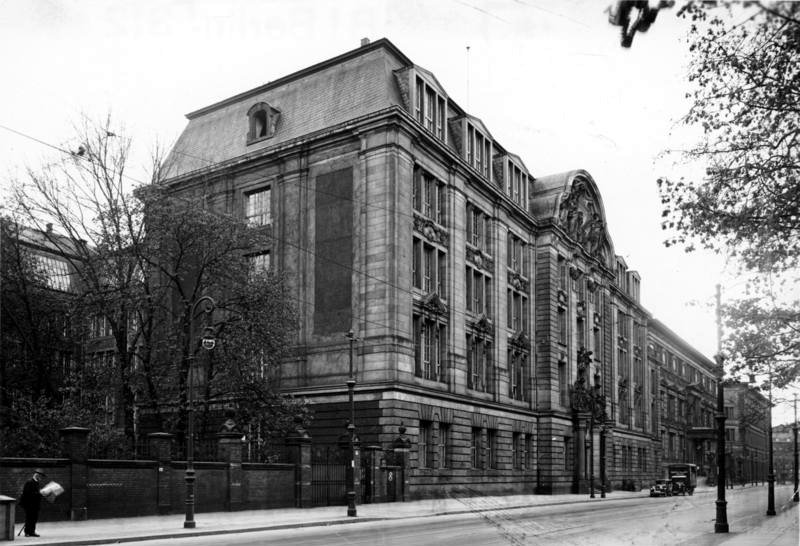
In January 1933, Hermann Göring, Hitler's minister without portfolio, was appointed the head of the Prussian Police and began filling the political and intelligence units of the Prussian Secret Police with Nazi Party members. A year after the organizations inception, Göring wrote in a British publication about having created the organization on his own initiative and how he was "chiefly responsible" for the elimination of the Marxist and Communist threat to Germany and Prussia. Describing the activities of the organization, Göring boasted about the utter ruthlessness required for Germany's recovery, the establishment of concentration camps for that purpose, and even went on to claim that excesses were committed in the beginning, recounting how beatings took place here and there. On 26 April 1933, he reorganized the force's Amt III as the Gestapa (better-known by the "sobriquet" Gestapo), a secret state police intended to serve the Nazi cause. Less than two weeks later in early May 1933, the Gestapo moved into their Berlin headquarters at Prinz-Albrecht-Straße 8.
With its 1936 merging with the Kripo (National criminal police) to form sub-units of the Sicherheitspolizei (SiPo; Security Police), the Gestapo was classified as a government agency. Himmler by his appointment to Chef der Deutschen Polizei (Chief of German Police), along with serving as Reichsführer-SS made him independent of Interior Minister Wilhelm Frick's nominal control.
The SiPo was placed under the direct command of Reinhard Heydrich who was already chief of the Nazi Party's intelligence service, the Sicherheitsdienst (SD). The idea was to fully combine the party agency, the SD, with the SiPo, the state agency. SiPo members were encouraged to become members of the SS. However, in practice, the SiPo and the SD came into jurisdictional and operational conflict. Gestapo and Kripo had many experienced, professional policemen and investigators, who considered the SD to be a less competent agency.
In September 1939, the SiPo together with the SD were merged into the newly created Reichssicherheitshauptamt (RSHA: Reich Main Security Office). Both the Gestapo and Kripo became distinct departments within the RSHA. Although the Sicherheitspolizei was officially disbanded, the term SiPo was figuratively used to describe any RSHA personnel throughout the remainder of the war. In lieu of naming convention changes, the original construct of the SiPo, Gestapo, and Kripo cannot be fully comprehended as "discrete entities", since they ultimately formed "a conglomerate in which each was wedded to each other and the SS through its Security Service, the SD."
The creation of the RSHA represented the formalization, at the top level, of the relationship under which the SD served as the intelligence agency for the security police. A similar coordination existed in the local offices. Within Germany and areas which were incorporated within the Reich for the purpose of civil administration, local offices of the Gestapo, criminal police, and SD were formally separate. They were subject to coordination by inspectors of the security police and SD on the staffs of the local higher SS and police leaders, however, and one of the principal functions of the local SD units was to serve as the intelligence agency for the local Gestapo units. In the occupied territories, the formal relationship between local units of the Gestapo, criminal police, and SD was slightly closer.
The Gestapo became known as RSHA Amt IV ("Department or Office IV") with Heinrich Müller as its chief. In January 1943, Himmler appointed Ernst Kaltenbrunner RSHA chief; almost seven months after Heydrich had been assassinated.
The specific internal departments of Amt IV were as follows:
Department A (Political Opponents)
- -- Communists (A1)
- -- Counter-sabotage (A2)
- -- Reactionaries, liberals and opposition (A3)
- -- Protective services (A4)
Department B (Sects and Churches)
- -- Catholicism (B1)
- -- Protestantism (B2)
- -- Freemasons and other churches (B3)
- -- Jewish affairs (B4)
Department C (Administration and Party Affairs)
Central administrative office of the Gestapo, responsible for card files of all personnel including all officials.
- -- Files, card, indexes, information and administration (C1)
- -- Protective custody (C2)
- -- Press office (C3)
- -- NSDAP matters (C4)
Department B (Sects and Churches)
Administration for regions outside the Reich.
- -- Protectorate affairs, Protectorate of Bohemia and Moravia, regions of Yugoslavia, Greece (D1)
- -- 1st Belgrade Special Combat detachment
- -- General Government(D2)
- -- Confidential office - hostile foreigners, emigrants (D3)
- -- Occupied territories - France, Belgium, Holland, Norway, Denmark (D4)
- -- Occupied Eastern territories (D5)
Department B (Sects and Churches)
- -- In the Reich (E1)
- -- Policy and economic formation (E2)
- -- West (E3)
- -- Scandinavia (North)(E4)
- -- East (E5)
- -- South (E6)
In 1941 Referat N, the central command office of the Gestapo was formed. However, these internal departments remained and the Gestapo continued to be a department under the RSHA umbrella. The local offices of the Gestapo, known as Gestapo Leitstellen and Stellen, answered to a local commander known as the Inspekteur der Sicherheitspolizei und des SD ("Inspector of the Security Police and Security Service") who, in turn, was under the dual command of Referat N of the Gestapo and also his local SS and Police Leader.
The Gestapo also maintained offices at all Nazi concentration camps, held an office on the staff of the SS and Police Leaders, and supplied personnel as needed to formations such as the Einsatzgruppen. Personnel assigned to these auxiliary duties were often removed from the Gestapo chain of command and fell under the authority of branches of the SS.
Identification: Criminal Local Police ID Tag - Oval - Nickel or Brass
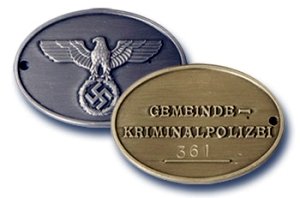
Worn by the plain clothes Police and Security services and the Army Secret Field Police, they were presented as proof of identity when on duty. These units were small in comparison to military units and many discs were destroyed at war’s end in order to hide identities and thus avoid prosecution.
